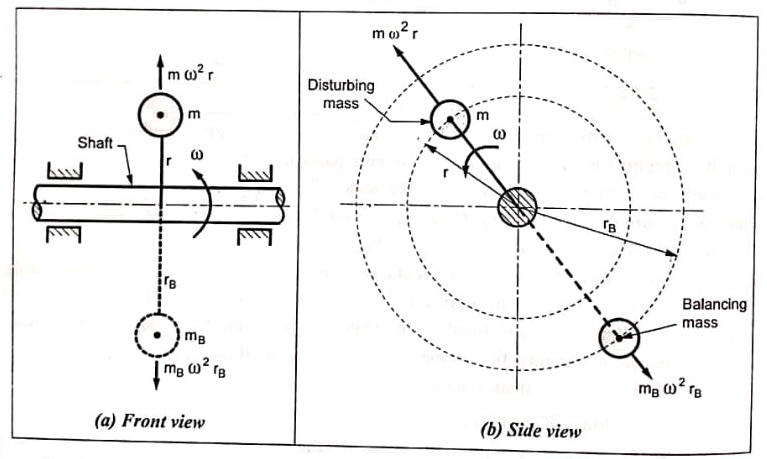Static Balancing
A system of rotating masses is said to be in static balance if the combined mass centre of the system lies on the axis of rotation, static vs dynamic balancing.
Condition for static balancing : The net dynamic force acting on the shaft is equal to zero. In other words, the centre of the masses of the system must lie on the axis of rotation.
- Ensures the object remains stationary when placed at rest.
- Corrects imbalance in a single plane.
- Focuses on preventing vertical oscillation.
- Typically used for simpler, slower-rotating objects like tires.
Dynamic Balancing
When several masses rotate in different planes, in addition to the out of balance centrifugal forces, the couple also produced. A system of rotating masses is in dynamic balance when there does not exist any resultant centrifugal forces as well as resultant couple.
- Ensures smooth rotation without wobbling or vibration.
- Corrects imbalance across multiple planes.
- Focuses on both horizontal and vertical forces.
- Essential for high-speed machinery like turbines or engines.

Conditions for dynamic balancing
- The net dynamic force acting on the shaft is equal to zero. This is the condition for static balancing.
- The net couple due to the dynamic forces acting on the shaft is equal to zero. In other words, the algebraic sum of moments about any point in the plane must be zero.
Balancing of Several Masses Rotating in Different Planes (Dalby’s Method)
The technique of tackling this problem is to transfer the centrifugal force acting in each plane to a single parallel plane which is usually termed as reference plane (R.P).
Then the procedure for static vs dynamic balancing is almost the same as for different forces acting in the same plane. The transference of a force from one plane to another plane is explained as given below.
Transference of a Force from One Plane to Another Plane
Consider a force F acts radially outward in plane A and it is intended to transfer this force to another parallel plane (B) called reference plane which is situated at a distance of ‘l’ from the plane A, as shown in Fig.
Now introduce two equal and opposite forces F1 and F2, both being parallel to force F, in the reference plane. The equilibrium of the system does not change due to the introduction of forces F1 and F2. The net effect would be a single force F1 in the reference plane having the direction of the original force F along with a couple of magnitude F x l formed by the forces F and F2.
Thus the effect of transferring a force F acting in one plane to another plane (reference plane) is equivalent to transfer of the same force F in magnitude and direction in the reference plane accompanied by a couple of magnitude F l.
Conditions for Complete Balancing
In order to have the complete balance of the several rotating masses in different planes, the following two conditions must be satisfied.
- The resultant centrifugal force must be zero, and
- The resultant couple (the couple about the reference plane) must be zero.
Illustration
Let us consider any number of masses (say, four masses m1, m2, m3 and m4 revolving in planes A, B, C and D respectively, as shown in Fig(a). The relative angular positions of various masses are shown in the side view [Fig(b)]. Let mx and my be the balancing masses to be introduced in planes X and Y respectively.
Procedure of Balancing
- Take any one of the planes, say X, as the reference plane (R.P). Distances to the left of this reference plane are taken with negative sign and those to right with positive sign.
- Tabulate the forces and couples as shown in Table. It may be noted that the planes (in column (1)) are tabulated in the same order which they occurs from left to right (in Fig(a)).
| Read More Topics |
| Direct sequence spread spectrum |
| Frequency hopping spread spectrum |
| Pseudo noise sequence |





